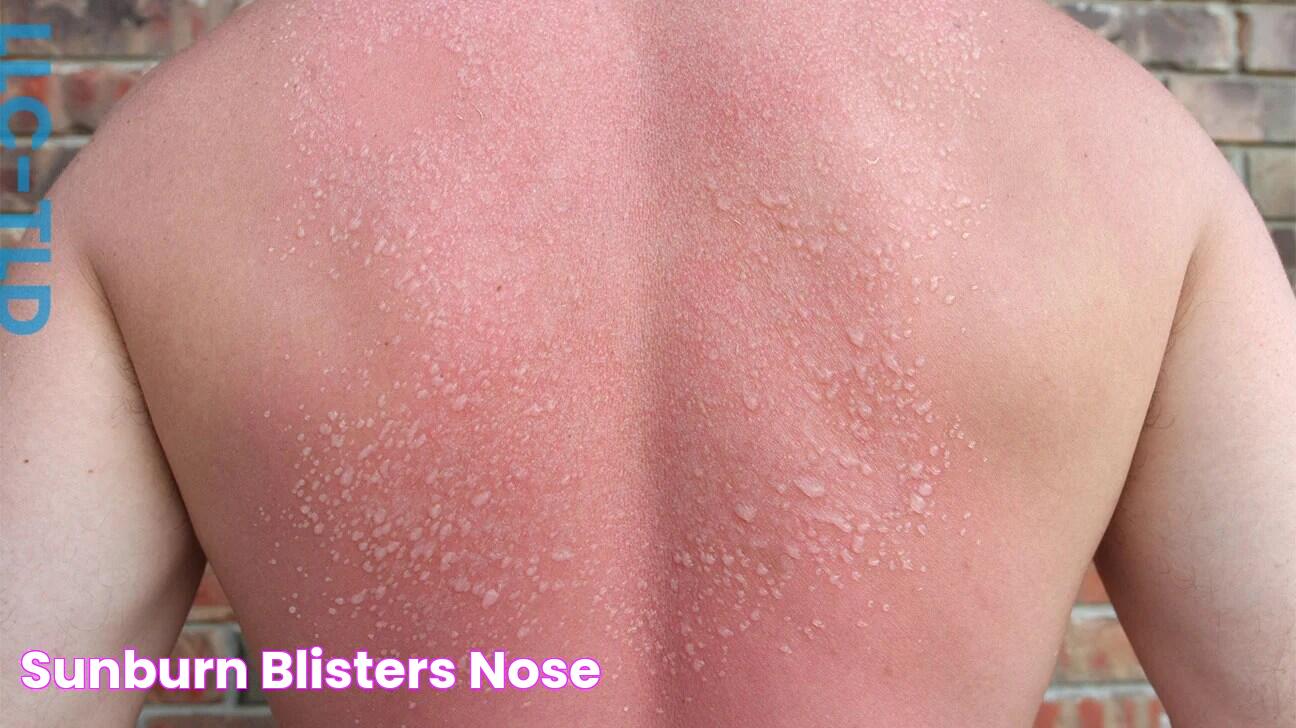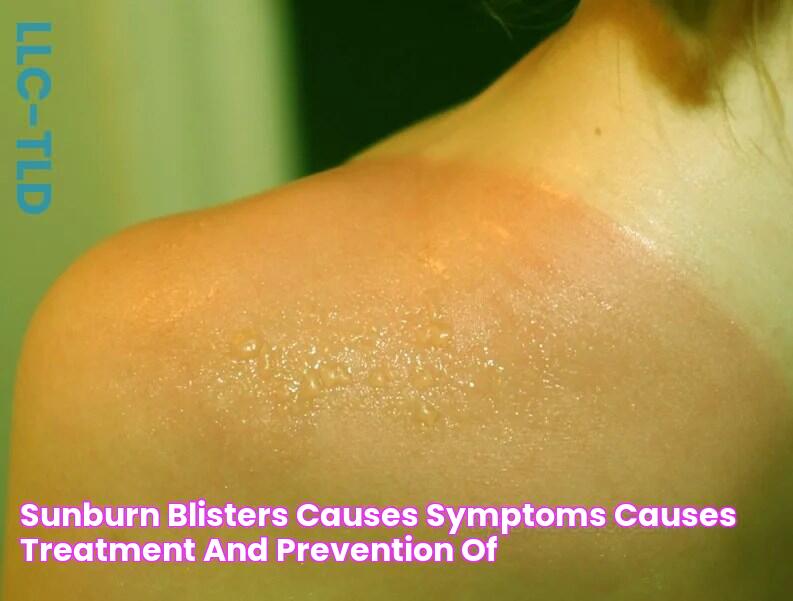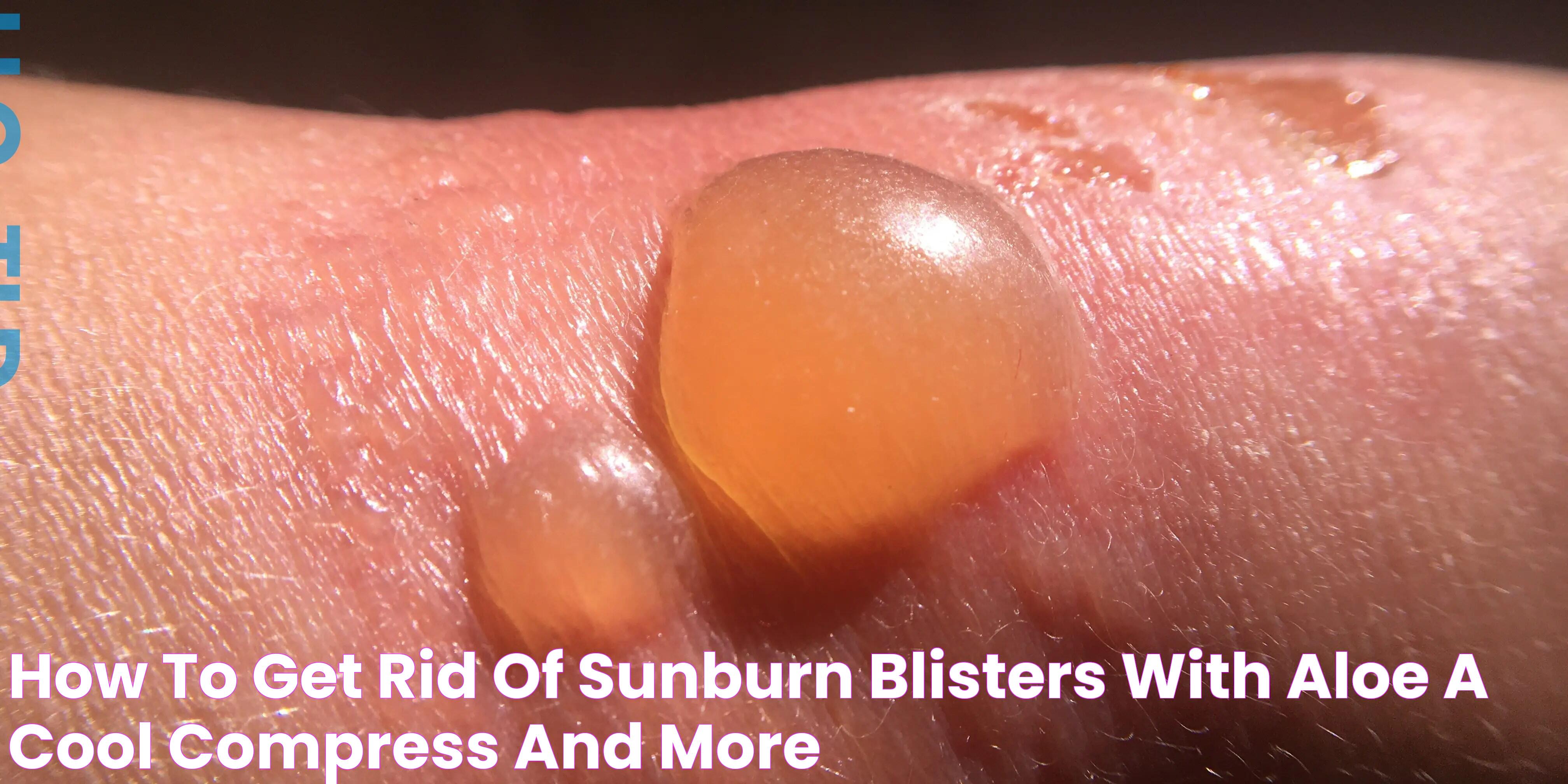Warning: Yellow Sunburn Blisters - What You Need To Know
Yellow sunburn blisters are a type of skin lesion that can occur after exposure to ultraviolet (UV) radiation. They are typically filled with a clear or yellow fluid and can be painful and itchy. Yellow sunburn blisters are most common on the shoulders, back, and chest, but they can occur anywhere on the body that has been exposed to the sun.
Yellow sunburn blisters are caused by damage to the skin's DNA. UV radiation can penetrate the skin and damage the DNA in the cells of the epidermis, the outermost layer of the skin. This damage can lead to the formation of sunburn blisters. Yellow sunburn blisters are more common in people with fair skin, as they have less melanin to protect their skin from UV radiation.
Yellow sunburn blisters can be a sign of a more serious condition, such as a second-degree sunburn. Second-degree sunburns can cause blisters, pain, and swelling. They can also lead to scarring. If you have yellow sunburn blisters, it is important to see a doctor to rule out any more serious conditions.
Read also:The Ultimate Guide To Apponfly A Powerful App Testing Tool
Yellow Sunburn Blisters
Yellow sunburn blisters are a common skin condition that can occur after exposure to ultraviolet (UV) radiation. They are typically filled with a clear or yellow fluid and can be painful and itchy. Yellow sunburn blisters are most common on the shoulders, back, and chest, but they can occur anywhere on the body that has been exposed to the sun.
- Cause: UV radiation damage to skin cells
- Symptom: Clear or yellow fluid-filled blisters
- Treatment: Cool compresses, aloe vera, pain relievers
- Prevention: Sunscreen, protective clothing, shade
- Complications: Infection, scarring
- Risk factors: Fair skin, prolonged sun exposure
- Warning signs: Fever, chills, nausea
Yellow sunburn blisters can be a sign of a more serious condition, such as a second-degree sunburn. Second-degree sunburns can cause blisters, pain, and swelling. They can also lead to scarring. If you have yellow sunburn blisters, it is important to see a doctor to rule out any more serious conditions.
1. Cause
Ultraviolet (UV) radiation damage to skin cells is the primary cause of yellow sunburn blisters. UV radiation is a type of electromagnetic radiation that is emitted by the sun. When UV radiation penetrates the skin, it can damage the DNA in the cells of the epidermis, the outermost layer of the skin. This damage can lead to the formation of sunburn blisters.
- Facet 1: DNA damage
UV radiation can damage the DNA in skin cells by causing the formation of thymidine dimers. Thymidine dimers are covalent bonds that form between two thymine molecules in the DNA strand. These dimers can block the transcription of DNA, which is necessary for cell division and repair. The accumulation of thymidine dimers can lead to cell death and the formation of sunburn blisters.
- Facet 2: Inflammation
UV radiation can also trigger an inflammatory response in the skin. This inflammation is caused by the release of cytokines, which are signaling molecules that recruit immune cells to the site of damage. The inflammation can lead to redness, swelling, and pain. It can also contribute to the formation of sunburn blisters.
- Facet 3: Apoptosis
UV radiation can also induce apoptosis, or programmed cell death, in skin cells. Apoptosis is a normal process that occurs in the body to remove damaged or unwanted cells. However, excessive apoptosis can lead to the formation of sunburn blisters.
Read also:
- Yellowstone Sarah Atwoods Shocking Death Stuns Fans
- Facet 4: Epidermal barrier disruption
UV radiation can damage the epidermal barrier, which is the outermost layer of the skin. This damage can allow water and electrolytes to escape from the skin, leading to dehydration and the formation of sunburn blisters.
The combination of these factors can lead to the formation of yellow sunburn blisters. These blisters are typically filled with a clear or yellow fluid and can be painful and itchy. Yellow sunburn blisters are most common on the shoulders, back, and chest, but they can occur anywhere on the body that has been exposed to the sun.
2. Symptom
Clear or yellow fluid-filled blisters are a characteristic symptom of yellow sunburn blisters. These blisters are caused by damage to the skin's DNA, which can occur after exposure to ultraviolet (UV) radiation. The damaged skin cells release fluid, which accumulates under the skin's surface and forms blisters.
The color of the fluid in the blisters can vary from clear to yellow. Clear blisters are typically filled with serum, which is a clear fluid that contains proteins, electrolytes, and water. Yellow blisters are filled with serum that has been mixed with blood or other inflammatory cells. The presence of blood or inflammatory cells can give the blisters a yellow appearance.
Clear or yellow fluid-filled blisters are a common symptom of sunburn. However, they can also be a sign of other skin conditions, such as:
- Second-degree burns
- Herpes simplex virus (HSV)
- Varicella-zoster virus (VZV)
- Bullous pemphigoid
If you have clear or yellow fluid-filled blisters, it is important to see a doctor to rule out any other underlying skin conditions.
3. Treatment
Cool compresses, aloe vera, and pain relievers are common treatments for yellow sunburn blisters. These treatments can help to reduce pain, inflammation, and itching.
- Cool compresses
Cool compresses can help to reduce pain and inflammation by constricting blood vessels and numbing the skin. To make a cool compress, soak a washcloth in cold water and apply it to the affected area for 15-20 minutes at a time. You can repeat this process several times a day.
- Aloe vera
Aloe vera is a natural anti-inflammatory that can help to soothe and heal sunburn blisters. To use aloe vera, apply the gel from an aloe vera plant directly to the affected area. You can also find aloe vera gel in over-the-counter products, such as lotions and creams.
- Pain relievers
Pain relievers, such as ibuprofen or acetaminophen, can help to reduce pain and inflammation associated with yellow sunburn blisters. Follow the directions on the package for how to use these medications.
In addition to these treatments, it is important to keep the affected area clean and dry. Avoid scratching or popping the blisters, as this can lead to infection. If the blisters are large or painful, you may need to see a doctor for further treatment.
4. Prevention
Sunscreen, protective clothing, and shade are essential for preventing yellow sunburn blisters. These measures can help to block ultraviolet (UV) radiation from reaching the skin and causing damage.
UV radiation is a type of electromagnetic radiation that is emitted by the sun. When UV radiation penetrates the skin, it can damage the DNA in the cells of the epidermis, the outermost layer of the skin. This damage can lead to the formation of sunburn blisters.
Sunscreen is an effective way to block UV radiation from reaching the skin. Sunscreens contain ingredients that absorb or scatter UV radiation, preventing it from penetrating the skin. Sunscreens are available in a variety of forms, including lotions, sprays, and sticks. It is important to choose a sunscreen that has a broad-spectrum SPF of 30 or higher and to apply it liberally to all exposed skin 15 minutes before going outside.
Protective clothing can also help to block UV radiation from reaching the skin. Clothing made from tightly woven fabrics, such as cotton or linen, can provide good protection from the sun. Wearing a hat with a wide brim can help to protect the face, neck, and ears from UV radiation.
Shade is another effective way to prevent UV radiation from reaching the skin. Seek out shade under trees, umbrellas, or other structures when possible.
By following these preventive measures, you can help to reduce your risk of developing yellow sunburn blisters.
5. Complications
Yellow sunburn blisters can lead to a number of complications, including infection and scarring. These complications can be serious, so it is important to be aware of them and to take steps to prevent them.
- Infection
Yellow sunburn blisters are a break in the skin, which can allow bacteria to enter and cause an infection. Symptoms of an infected blister include redness, swelling, pain, and drainage of pus. If you think your blister is infected, it is important to see a doctor right away. The doctor may prescribe antibiotics to treat the infection.
- Scarring
Yellow sunburn blisters can also lead to scarring. Scarring occurs when the skin is damaged and the body produces collagen to repair the damage. In some cases, the collagen can build up and form a scar. Scars can be unsightly and can affect the function of the skin. There are a number of treatments that can help to reduce scarring, but it is important to see a doctor as soon as possible after the blister forms to discuss your options.
By taking steps to prevent yellow sunburn blisters, you can reduce your risk of developing these complications. These steps include wearing sunscreen, protective clothing, and seeking shade when possible.
6. Risk factors
Fair skin and prolonged sun exposure are two major risk factors for developing yellow sunburn blisters. Fair skin has less melanin, a pigment that helps to protect the skin from UV radiation. As a result, fair-skinned people are more likely to burn and develop blisters when exposed to the sun. Prolonged sun exposure, regardless of skin type, can also increase the risk of sunburn blisters.
The combination of fair skin and prolonged sun exposure is particularly dangerous. People with fair skin who spend a lot of time in the sun are at a high risk of developing severe sunburns, including yellow sunburn blisters. These blisters can be painful, itchy, and can lead to infection and scarring.
It is important to take steps to protect yourself from the sun, especially if you have fair skin. These steps include:
- Wearing sunscreen with a broad-spectrum SPF of 30 or higher
- Reapplying sunscreen every two hours, or more often if you are swimming or sweating
- Wearing protective clothing, such as long sleeves and pants
- Seeking shade when possible
7. Warning signs
Fever, chills, and nausea are warning signs that can accompany yellow sunburn blisters. These symptoms indicate that the sunburn is severe and may require medical attention. Fever is a body temperature of 100.4 degrees Fahrenheit or higher. Chills are a sensation of coldness that can occur even when the body temperature is elevated. Nausea is a feeling of queasiness and an urge to vomit.
These symptoms can occur when the sunburn is severe enough to cause systemic inflammation. Systemic inflammation is a body-wide response to injury or infection. When the skin is sunburned, the body releases inflammatory mediators that can cause fever, chills, and nausea.
It is important to seek medical attention if you experience any of these warning signs along with yellow sunburn blisters. Severe sunburns can lead to dehydration, electrolyte imbalance, and other serious health problems.
Frequently Asked Questions About Yellow Sunburn Blisters
Question 1: What are yellow sunburn blisters?
Answer: Yellow sunburn blisters are a type of skin lesion that can occur after exposure to ultraviolet (UV) radiation. They are typically filled with a clear or yellow fluid and can be painful and itchy. Yellow sunburn blisters are more common on the shoulders, back, and chest, but they can occur anywhere on the body that has been exposed to the sun.
Question 2: What causes yellow sunburn blisters?
Answer: Yellow sunburn blisters are caused by damage to the skin's DNA. UV radiation can penetrate the skin and damage the DNA in the cells of the epidermis, the outermost layer of the skin. This damage can lead to the formation of sunburn blisters.
Question 3: What are the symptoms of yellow sunburn blisters?
Answer: The most common symptom of yellow sunburn blisters is the presence of clear or yellow fluid-filled blisters on the skin. Other symptoms can include pain, itching, redness, and swelling. In severe cases, yellow sunburn blisters can also lead to fever, chills, and nausea.
Question 4: How are yellow sunburn blisters treated?
Answer: Treatment for yellow sunburn blisters typically involves reducing pain and inflammation and preventing infection. This can be done with cool compresses, aloe vera gel, and over-the-counter pain relievers. In severe cases, antibiotics may be necessary to prevent or treat infection.
Question 5: How can I prevent yellow sunburn blisters?
Answer: The best way to prevent yellow sunburn blisters is to protect your skin from UV radiation. This can be done by wearing sunscreen, protective clothing, and seeking shade when possible. It is also important to avoid prolonged sun exposure, especially during the peak hours of 10am to 4pm.
Question 6: When should I see a doctor for yellow sunburn blisters?
Answer: You should see a doctor if you have any of the following symptoms:
- Blisters that are large or painful
- Blisters that are filled with pus or blood
- Blisters that are accompanied by fever, chills, or nausea
- Blisters that do not improve with home treatment
Summary: Yellow sunburn blisters are a common skin condition that can be painful and itchy. They are caused by damage to the skin's DNA from exposure to UV radiation. Treatment for yellow sunburn blisters typically involves reducing pain and inflammation and preventing infection. The best way to prevent yellow sunburn blisters is to protect your skin from UV radiation by wearing sunscreen, protective clothing, and seeking shade when possible.
Transition to the next article section: For more information on yellow sunburn blisters, please consult a healthcare professional or visit the website of the American Academy of Dermatology.
Tips for Preventing and Treating Yellow Sunburn Blisters
Yellow sunburn blisters are a painful and common skin condition that can be caused by prolonged exposure to ultraviolet (UV) radiation. While yellow sunburn blisters are typically not a serious medical condition, they can be uncomfortable and unsightly. The following tips can help you prevent and treat yellow sunburn blisters:
Tip 1: Wear sunscreenSunscreen is the most effective way to prevent yellow sunburn blisters. Choose a sunscreen with a broad-spectrum SPF of 30 or higher and apply it liberally to all exposed skin 15 minutes before going outside. Reapply sunscreen every two hours, or more often if you are swimming or sweating.
Tip 2: Wear protective clothingProtective clothing can help to block UV radiation from reaching your skin. Wear long sleeves, pants, and a wide-brimmed hat when you are outdoors. Choose clothing made from tightly woven fabrics, such as cotton or linen.
Tip 3: Seek shadeSeek shade when possible, especially during the peak hours of 10am to 4pm. Find shade under trees, umbrellas, or other structures. You can also create your own shade by using a beach umbrella or canopy.
Tip 4: Take cool showers or bathsTaking cool showers or baths can help to soothe the pain and itching of yellow sunburn blisters. You can also apply cool compresses to the affected areas.
Tip 5: Apply aloe vera gelAloe vera gel has anti-inflammatory and cooling properties that can help to soothe the pain and itching of yellow sunburn blisters. Apply aloe vera gel directly to the affected areas several times a day.
Tip 6: Take over-the-counter pain relieversOver-the-counter pain relievers, such as ibuprofen or acetaminophen, can help to reduce the pain and inflammation of yellow sunburn blisters. Follow the directions on the package for how to use these medications.
Tip 7: Avoid popping blistersIt is important to avoid popping yellow sunburn blisters. Popping blisters can increase the risk of infection.
Tip 8: See a doctor if necessarySee a doctor if your yellow sunburn blisters are large, painful, or filled with pus. You should also see a doctor if you have a fever, chills, or nausea along with your sunburn blisters.
Summary: Yellow sunburn blisters are a common skin condition that can be painful and unsightly. By following these tips, you can help to prevent and treat yellow sunburn blisters.
Transition to the article's conclusion: For more information on yellow sunburn blisters, please consult a healthcare professional or visit the website of the American Academy of Dermatology.
Conclusion
Yellow sunburn blisters are a common skin condition that can be painful and unsightly. They are caused by damage to the skin's DNA from exposure to ultraviolet (UV) radiation. While yellow sunburn blisters are typically not a serious medical condition, they can be uncomfortable and can lead to complications such as infection and scarring. The best way to prevent yellow sunburn blisters is to protect your skin from UV radiation by wearing sunscreen, protective clothing, and seeking shade when possible.
If you do develop yellow sunburn blisters, there are a number of things you can do to treat them. These include taking cool showers or baths, applying aloe vera gel, and taking over-the-counter pain relievers. It is important to avoid popping blisters, as this can increase the risk of infection. If your blisters are large, painful, or filled with pus, you should see a doctor.
By following these tips, you can help to prevent and treat yellow sunburn blisters. Remember, the best way to protect your skin from UV radiation is to wear sunscreen, protective clothing, and seek shade when possible.
Unlock Incredible Savings At Sherwin Williams' 2025 Paint Sale Bonanza!
Discover Eiichiro Oda's Fortune: A Peek Into His Net Worth
Sadie Calvano: Uncover Her Journey Through The World Of TV Shows


